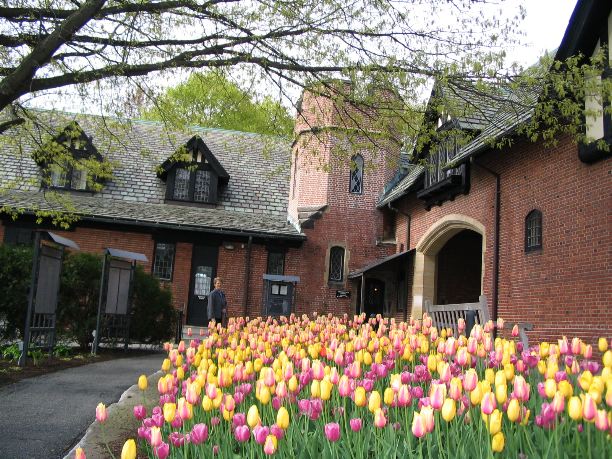
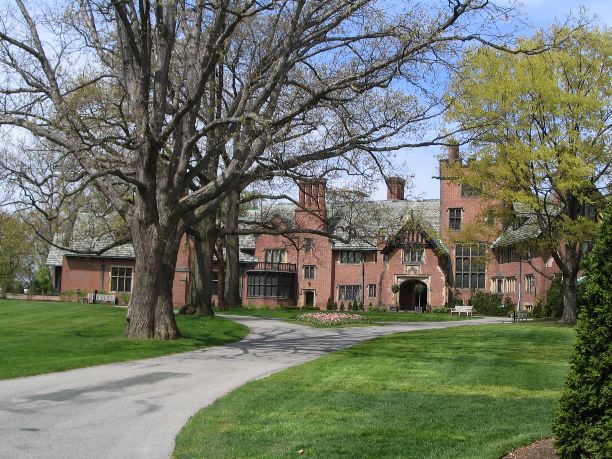
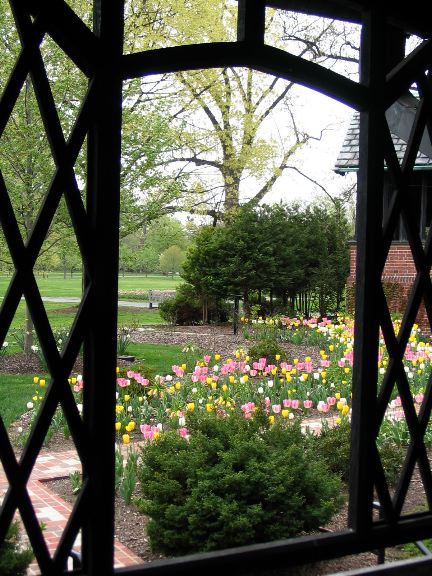
On the Road Again
April 29 - May 11, 2006
To go Back at any time,
use Browser's "Previous Page"
After a lengthy drive on state highways and byways, our first stop in Ohio was Akron, home of the Stan Hywet Hall and Gardens. (I suppose detouring to see the downtown areas of Kittaning, Butler and New Castle in PA as well as a look-see at Moraine State Park near Butler added a fair bit to our travel time but who would want to pass those up??) We were particularly surprised at how much development there is south of Youngstown, OH. All of that makes for a slow go.
"Stan Hywet" was once the dream house of Frank Seiberling, who founded Goodyear Tire and Rubber Company in 1898. His “country estate” was developed between 1912 and 1915. Those who remember their Anglo-Saxon, will have no trouble recalling that “stan hywet” means “stone quarry”, which the property once was. These days, with the quarry hardly recognizable as such, it is an enjoyable experience to wander through the gardens, especially on a pleasant Spring day. Judging from the many still sleepy trees and plants, though, it did seem a tad early in the season to be visiting. Here’s Patty at the entrance, a photo of the main house, and a view from its porch:



The estate has many beauty spots. One such is the Tea Garden --- even more stunning in the autumn, we were told by an amateur photographer and frequent visitor; another is a marvelous walk framed by countless birch trees.
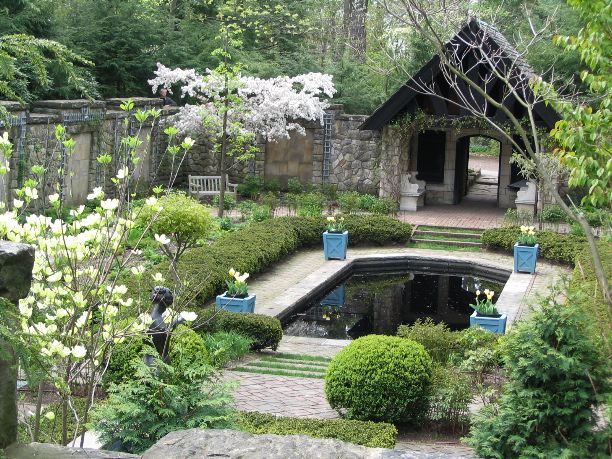
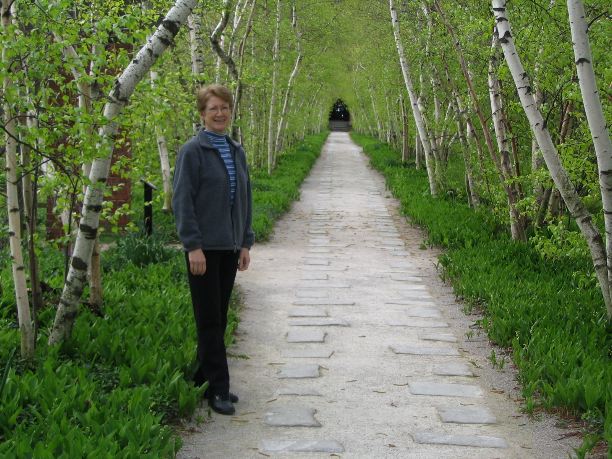
The old stable has become the cafe with tables gracing the former horse stalls.
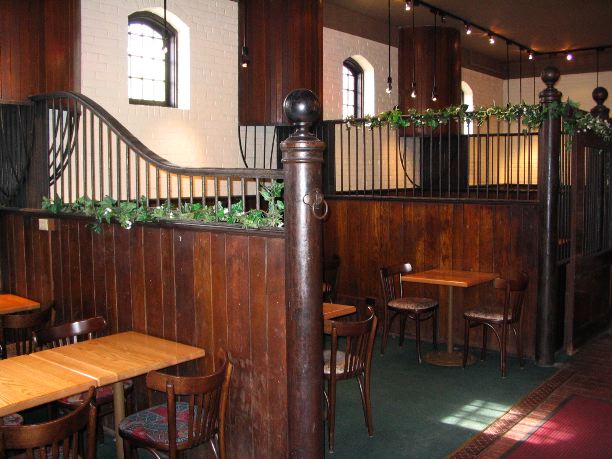
It reminded us of the Abbott’s Byer, a little canal-side eatery in North Yorkshire with a similar table arrangement.
Stan Hywet also has a claim to fame as the birthplace of AA. In May, 1935, through mutual friends, Henrietta Seiberling brought together Mr. Bill Wilson and Dr. Bob Smith, both admitted alcoholics. Their discussion, in the Gate Lodge at Stan Hywet (shown below), resulted in identifying the principles that were to become the cornerstone of Alcoholics Anonymous.
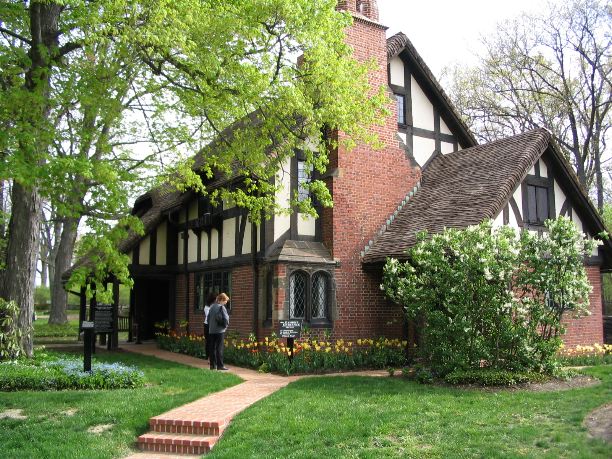
The estate also contains a conservatory in which we were surprised to find several model trains running through little villages as well as traveling overhead. Not surprisingly, the Goodyear blimp was represented.
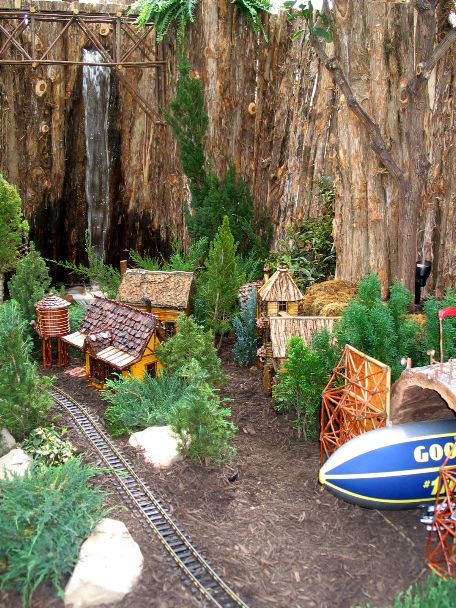
Leaving Stan Hywet behind, we headed across town to the aptly-named "Bike and Hike Trail". We chose a paved segment along the Cuyahoga River, leading past Silver Lake which is bordered by many fine, classy, modern homes. I couldn’t resist taking photos of two of the most unusual: one seemed inspired by cottages in Britain's Cotswolds and the other by a grinding mill.
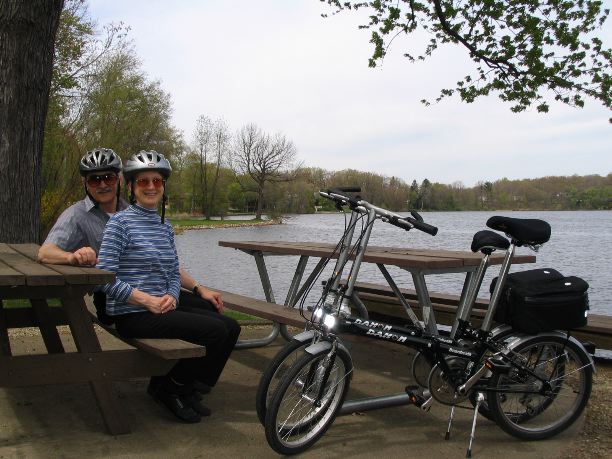
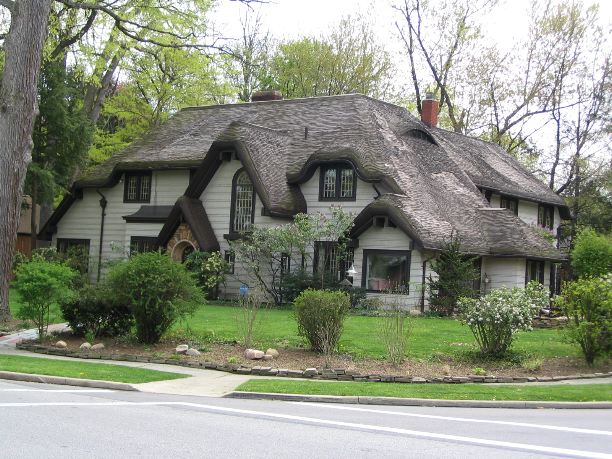
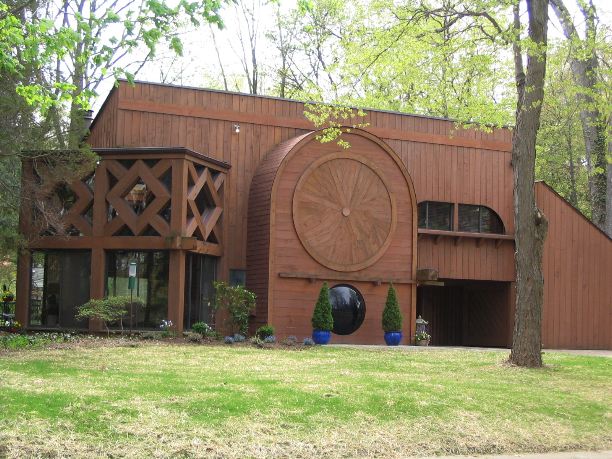
Just north of Orrville, OH, is the Johnson Woods Nature Preserve which protects a rare stand of “old growth” forest in a predominantly farming region. The larger trees, mainly red and white oak, are over 400 years old --- for around here, that's OLD! Some were 30 years of age when the Pilgrims arrived on the Mayflower and landed at Plymouth Rock in 1620.
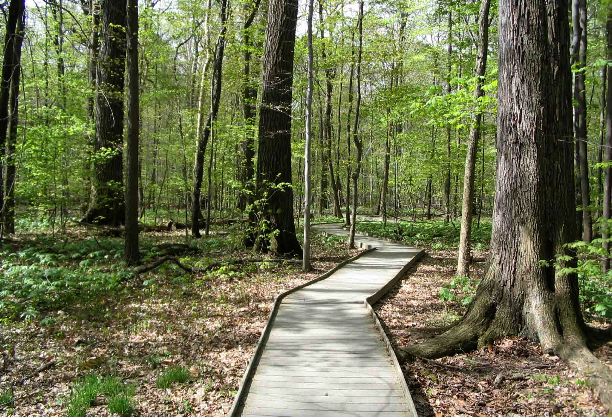
While we were in the area, we stopped in to see the photogenic Smuckers "sales room". The Smuckers Company had its start in Orrville in 1897, as you may remember. J. M. Smucker got his start selling apple butter from the back of his horse-drawn wagon.
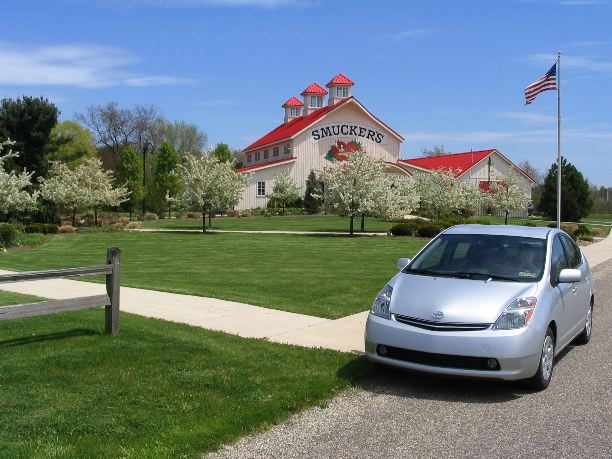
Down the road from Smuckers we looked up Lehman's Hardware Store in Kidron, Ohio. Although it sells on the Internet, too, in many ways it is an "old time" hardware store with objects rarely, if ever, seen nowadays. The basis for its success is that it services a large Amish and Mennonite community which, of course, has special needs. It must cater, as well, to wealthy tourists because we also saw some fabulous old-style bathtubs and refrigerators selling for many thousands of dollars!
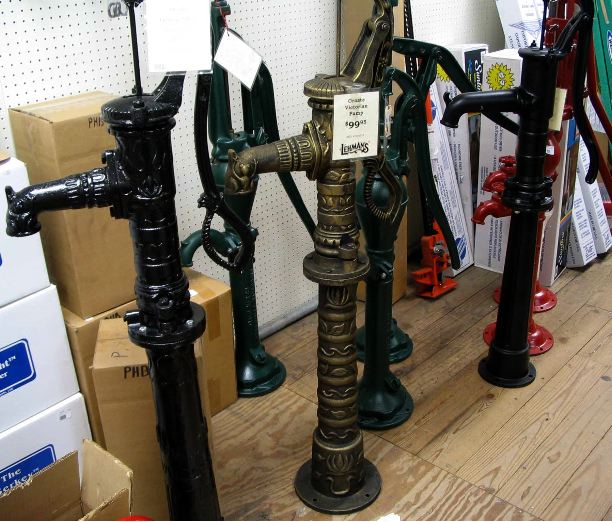
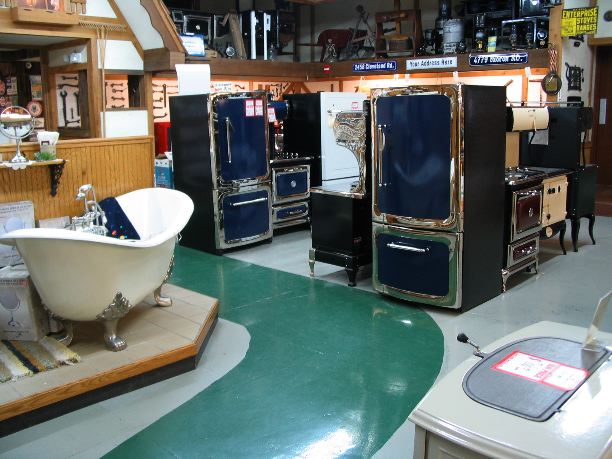
This sporty refrigerator being examined by Patty carried a price tag of almost $6000! Maybe, they just didn’t want to part with it.
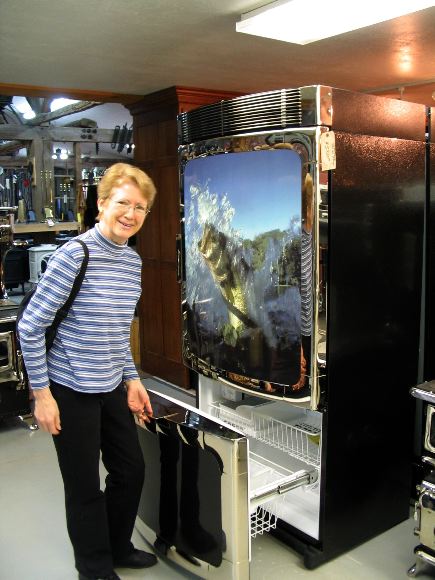
Farther west, we made a stop at Malabar Farm, the only working farm in the Ohio State Park System. After making a success of journalism, including a Pulitzer Prize, Louis Bromfield came home to central Ohio in 1938 and began to put into place the principles of grass-based, sustainable farming at his Malabar Farm. Bromfield's writings turned from fiction to nonfiction and his reputation and influence as a conservationist and farmer expanded throughout his life. Today, Malabar Farm State Park operates under Bromfield's management philosophy.
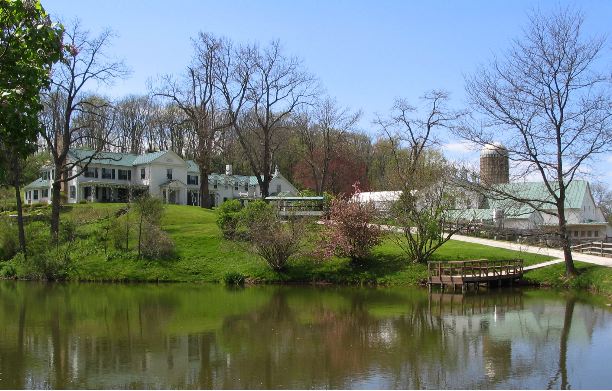
Here’s an interesting tidbit you may not know. Movie stars Humphrey Bogart and Lauren Bacall were married at Malabar Farm on May 21, 1945 and honeymooned there. (Several of Bromfield’s books had been made into movies so he was well known in Hollywood circles.)
Southeast of Malabar Farm and not far away is this bizarre creation. It’s called “Landoll’s Mohican Castle”.
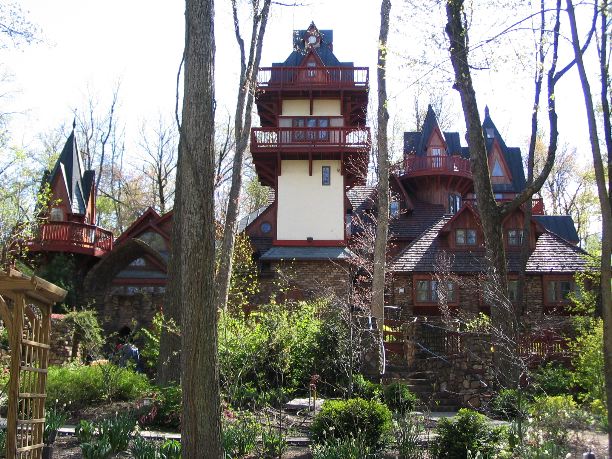
Reached only by rural roads, this secluded resort has been open just under 4 years. It was built by a fellow named Landoll who started a publishing business and, subsequently, sold it for a handsome profit. Building this lavish “castle” with his millions fulfilled a boyhood dream. And while a room for the night can be had for as little as $125 double on a midweek special, the usual rate is far higher. Best to bring your millions along if you intend to stay.
In Mansfield, Ohio, we visited Kingwood Center, a 47-acre former estate that is beautifully preserved and cared-for. What a great example of what a well drawn-up trust can do! Built in 1926 for Mr. and Mrs. Charles King, it opened as a public garden in 1953, one year after Mr. King's death. Mr. King, who was married and divorced twice, never had children. With a trust, he left most of his estate to the private foundation that continues to operate Kingwood Center today. By itself, we were told, the trust generates sufficient income to care for the property and has done so for 53 years --- there is no admission charge and no requests for donations!
Mr. King made his fortune in Mansfield working with the Ohio Brass Company. Hired as the company's first electrical engineer in 1893, eventually, he became President and Chairman of the Board of Ohio Brass.
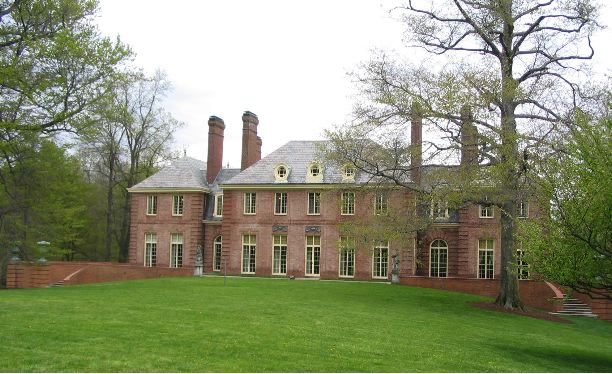
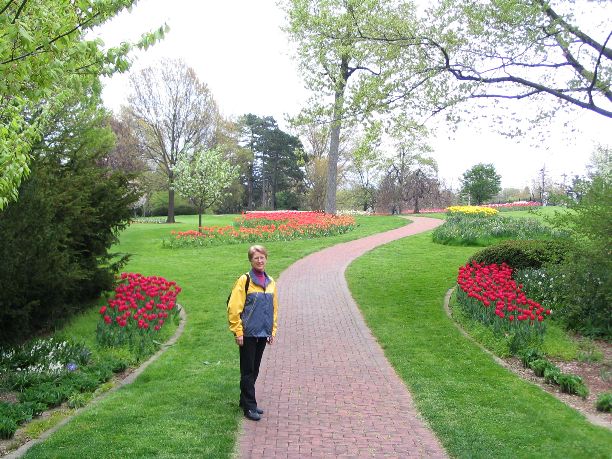
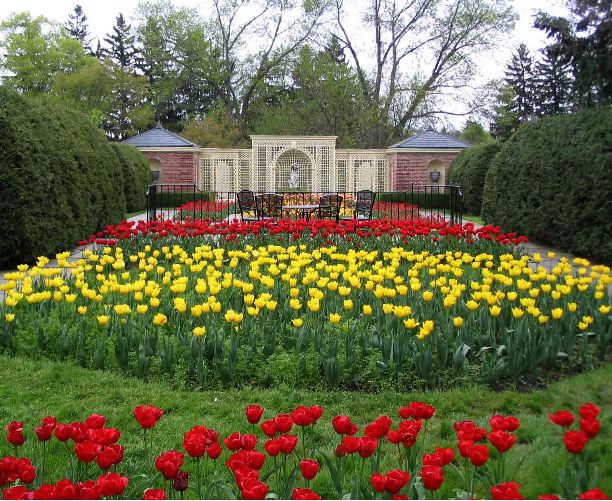
Talk about timing! We had no more finished exploring Kingwood Center than the predicted rain showers began. That wiped out our biking plans for the day but created another special experience. Because of the weather, we drove into the downtown area to see the Richland Carrousel Park. It contains a beautiful carousel that was built in 1991 --- the last such built in this country. The whole project cost about $1.5M and was meant to revitalize what had become a seedy part of town, complete with numerous bars, frequent fights and gunshots, prostitution and dope peddlers. When first proposed, the idea was greeted with guffaws but it has worked like a charm. The area is now quite attractive and the popular carousel draws locals and out-of-towners alike. Naturally, we rode the carousel and then sat in rocking chairs, enjoying the wonderful organ music, handsome animal carvings on the carousel and popcorn, of course, while the rain poured down. Sometimes, when you least expect it, things turn out better when plans go awry.
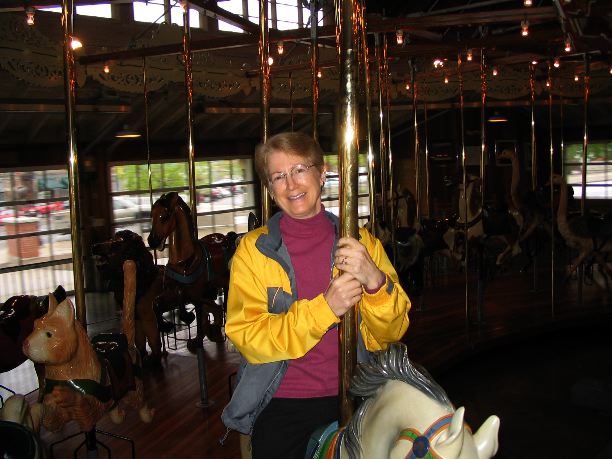
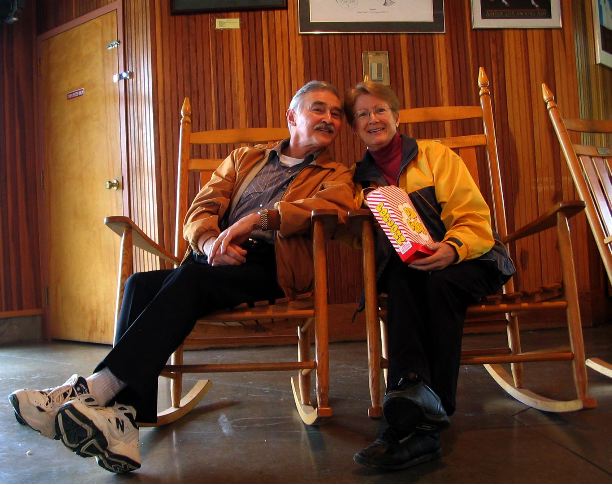
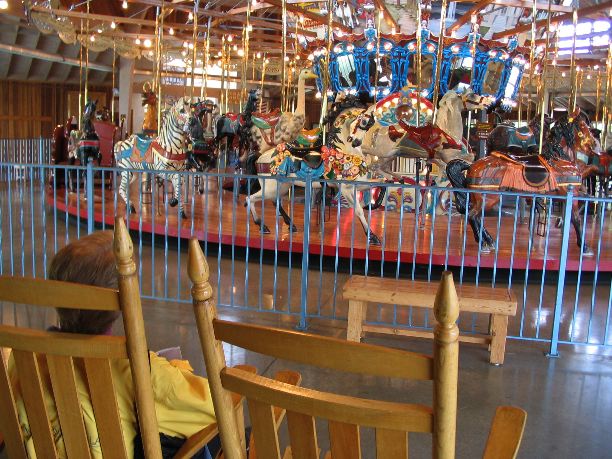
After our rain-out in Mansfield, we were ready for a new biking adventure in Fort Wayne, Indiana. This is where the St. Joseph River joins the St Marys River to form the Maumee. For transportation reasons alone, this area was important to the Miami Indians who lived here and to the French traders and settlers who followed. That’s because with a small boat one could travel from Lake Erie up the Maumee River to the future Fort Wayne, then up the St Marys and, with a short overland portage, down a branch of the Wabash River, into the Mississippi River and on to the gulf. Obviously, the trip could be taken in the opposite direction as well.
Fort Wayne has many miles of paved biking paths along its three rivers, way more than we could bike. However, the few miles we sampled convinced us that the bikeways do vary considerably in quality. One of the more scenic spots is here on the St Joseph River at Johnny Appleseed Park.
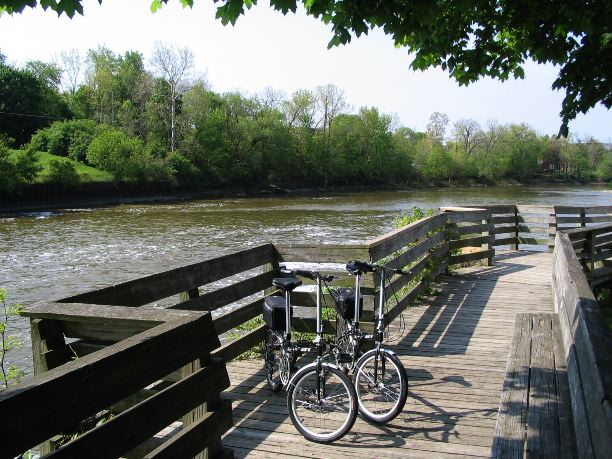
Other parts of the river greenway, as it is officially called, follow along the top of the city’s dikes.
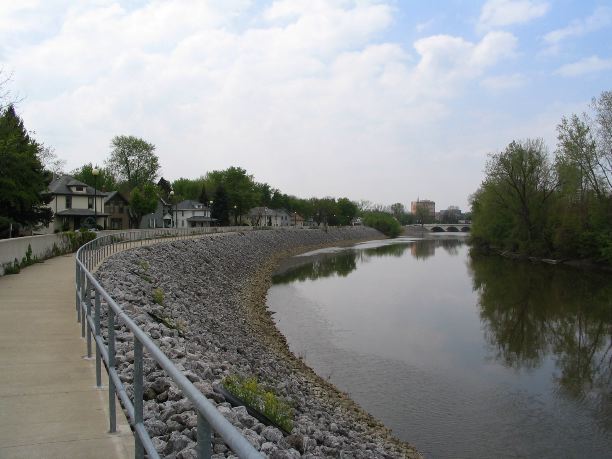
And what did we see? Well, an old railway depot ...
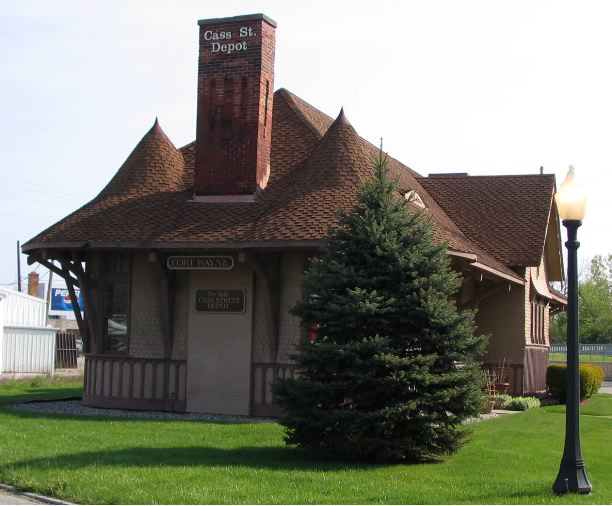
a super, skateboard park for the younger set ....
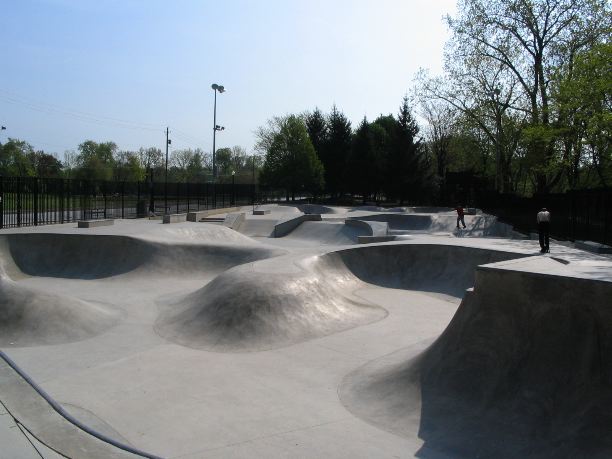
and downtown Fort Wayne itself.
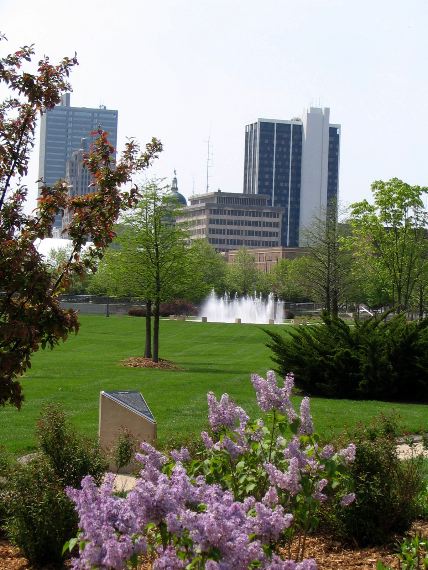
After traveling across Ohio seemingly in the footsteps of John Chapman, it felt only right to track down his grave site in Johnny Appleseed park. An interesting fellow, this John Chapman --- someday, I'll have to read a book on his life. Contrary to the popular notion that he simply wandered about planting apple seeds willy-nilly, he actually had a fair bit of business sense. It seems he was using his income from the orchards he established to finance his missionary work. Interestingly enough, long before there was a Malabar Farm, he lived near the locale of the farm longer than he lived anywhere else.
The first photo below is just an historical marker. The actual grave site is on top of the knoll beyond under the word “Johnny”. And, yes, those are apple trees you see, just past their blooming period when we were there. Such a peaceful spot --- but with a huge stadium within a stone’s throw, it must get noisy at times. The second photo is the grave site --- as best can be determined. As graves were not always marked indelibly back in the mid-1800s, there is some controversy as to whether this is the exact spot or not.
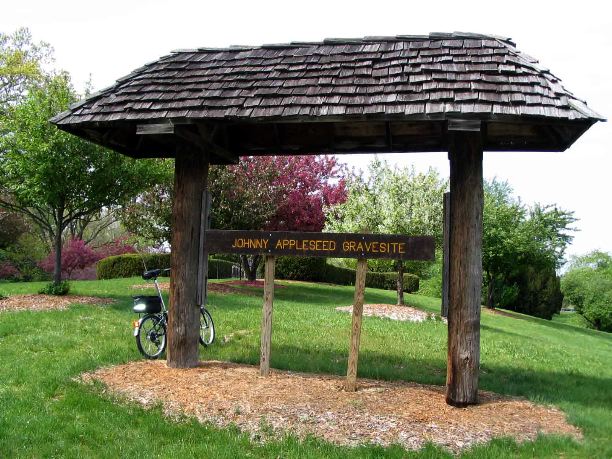
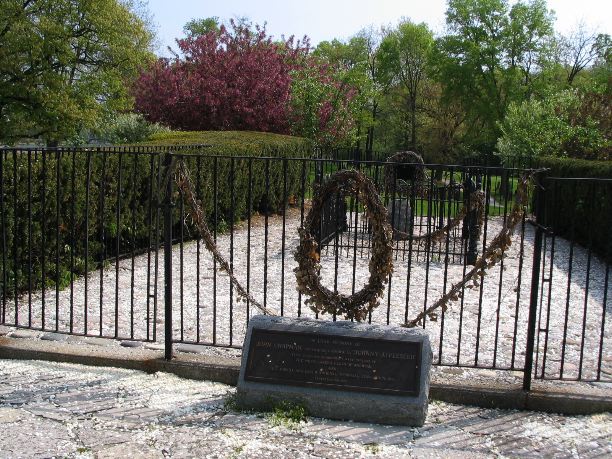
We stopped in Wabash, IN, to take a short hike along the banks of the Wabash River and snap a photo of the court house, knowing from the tourist office that a fascinating story revolves around this building. Wabash claims to have been the first city in the U.S. to be electrically lighted. On March 1, 1880 an extremely bright light was generated at the courthouse by a lamp up near the top, making "night into day". It had such an effect on folks who had come to town to see it that it was given a unique name: The Wabash Light.
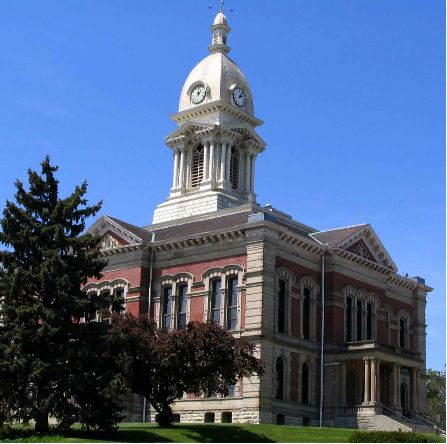
Having finally reached our intended destination, we found time before visiting Patty’s folks to ride the Four Sisters Bike Path in Rochelle, IL. Mostly suburban with some views across farmland, the path encircles about one-half of the city.
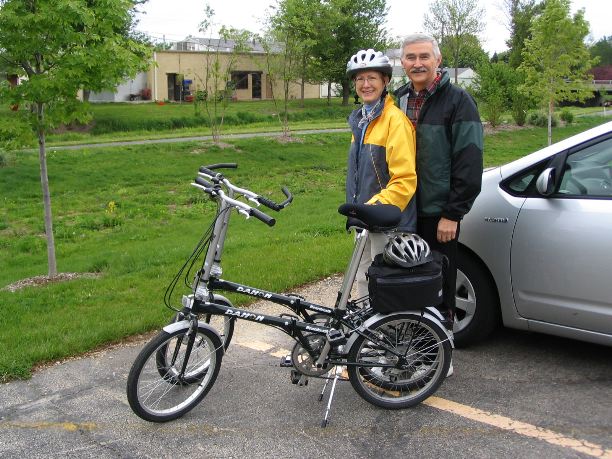
After several days in town, it was time to turn around and head back. We decided to take a two-night stay near Indianapolis to revisit the downtown area. Four and a half years ago, we spent several hours walking the downtown area and found it quite enjoyable but unfinished. There had been many ongoing projects under construction. Those we saw back then are now complete, we are happy to confirm; the central canal area adjacent to downtown is an especially pleasant and peaceful place to walk, jog or even bike.
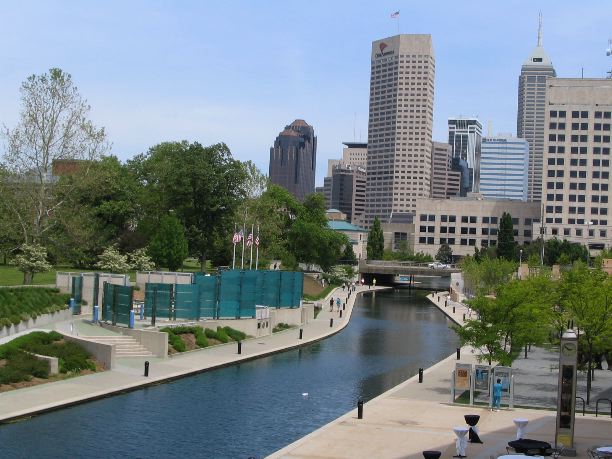
We chose to walk, taking in parts of downtown as well. To make the most of a difficult into-the-sun shot, Patty helped brighten my photo of the Soldiers’ and Sailors’ Monument.
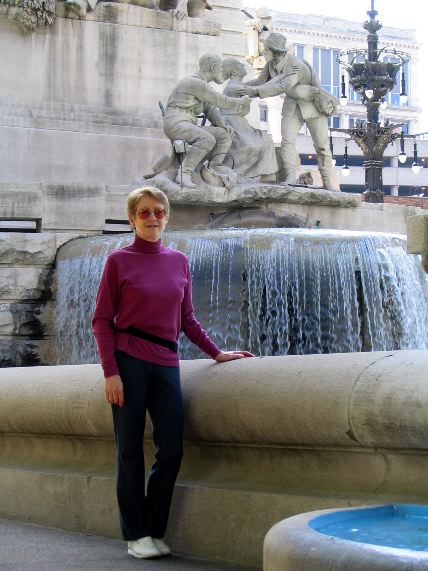
The Indianapolis Arts Garden is built over a busy downtown intersection; the “paper-thin” building behind it is actually shaped like a triangle.
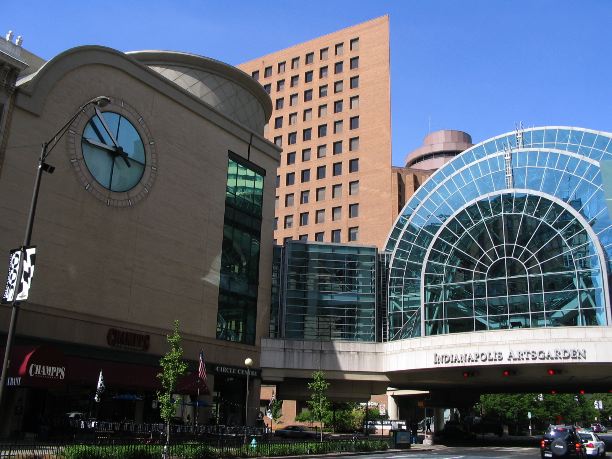
The Indiana State Museum opened its new building shortly after our last visit so it was on our sightseeing list. Here, we’re taking a well-deserved break on the museum’s terrace.
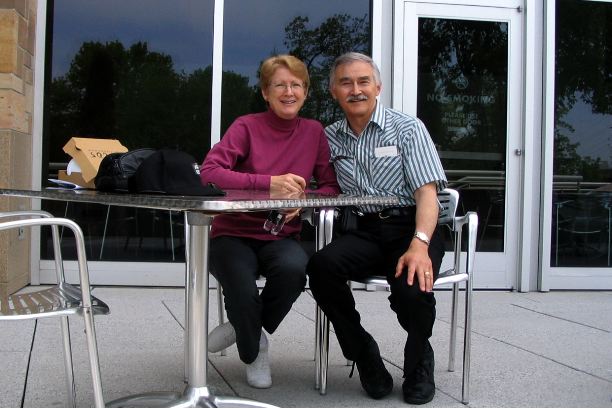
And, finally, just to prove that Indianapolisonians have a sense of humor as well as a sense of imagination, consider how much effort was expended to create this fossil-fantasy at the Childrens Museum:
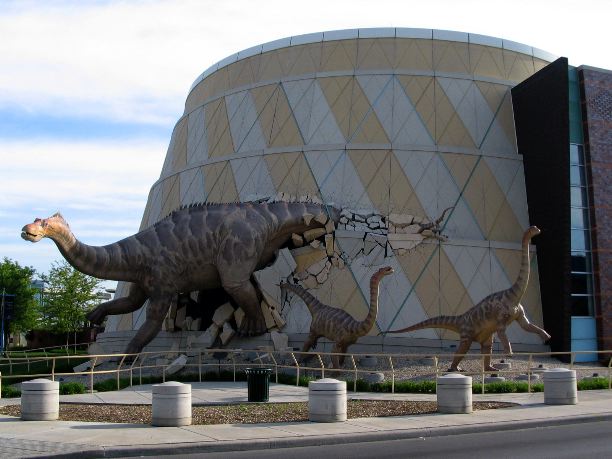
This latest journey of discovery ended on a wet note. The rain gods spoke eloquently of the need for us to return home as we were pummeled with heavy rain from Zanesville, OH, eastward ..... and not a single carousel in sight.